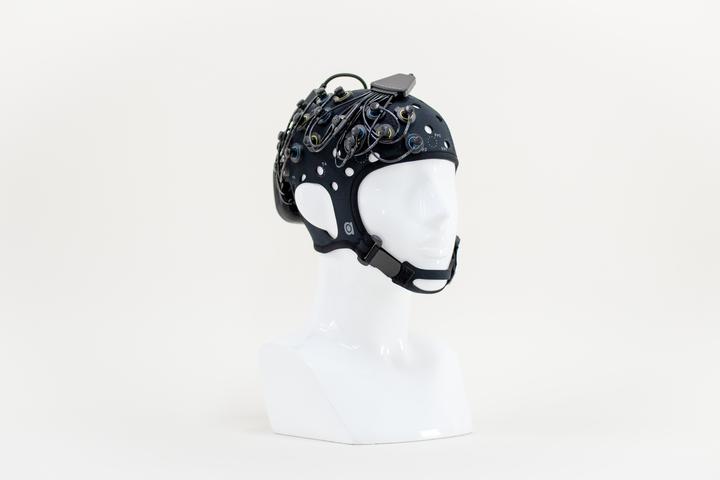Brite
A wearable & flexible multi-channel NIRS device for brain oxygenation measurement

Publications using the Brite
Differential contribution of between and within‐brain coupling to movement synchronization
A fundamental characteristic of the human brain that supports behavior is its capacity to create connections between brain regions. A promising approach holds that during social behavior, brain regions not only create connections with other brain …
Exploring Brain-Body Interactions in Parkinson’s Disease: A Study on Dual-Task Performance
Parkinson’s disease (PD) leads to impairments in cortical structures, resulting in motor and cognitive symptoms. Given the connection between brain structure deficits and physical symptoms in PD, assessing objective brain activity and body motion …
fNIRS-based hyperscanning reveals increased inter-brain synchronization in dorsolateral prefrontal cortex during interdisciplinary cooperation
The digital age has accelerated collaborative innovation among interdisciplinary groups, and the collaborative behavior between individuals from different disciplinary backgrounds has gradually become normalized.Previous studies have suggested that …
Method for Using Functional Near-Infrared Spectroscopy (fNIRS) to Explore Music-Induced Brain Activation in Orchestral Musicians in Concert
The act of performing music may induce a specific state of mind, musicians potentially becoming immersed and detached from the rest of the world. May this be measured? Does this state of mind change based on repetition? In collaboration with …
Pain classification using functional near infrared spectroscopy and assessment of virtual reality effects in cancer pain management
Objective measurements of pain and safe methods to alleviate it could revolutionize medicine. This study used functional near-infrared spectroscopy (fNIRS) and virtual reality (VR) to improve pain assessment and explore non-pharmacological pain …
Post-interaction neuroplasticity of inter-brain networks underlies the development of social relationship
Inter-brain coupling has been increasingly recognized for its role in supporting connectedness during social communication. Here we investigate whether inter-brain coupling is plastic and persists beyond the offset of social interaction, facilitating …
The emergence of moral alignment within human groups is facilitated by interbrain synchrony
Humans tend to align their behaviors and beliefs with their group peers. Establishing alignment between group members is crucial for group unity, yet the mechanisms underlying its emergence are under-explored. Here we examined the extent to which the …
A Rapid Cortical Learning Process Supporting Students’ Knowledge Construction During Real Classroom Teaching
Classroom teaching is essential for cognitive development and cultural evolution, yet its neurocognitive mechanisms remain unclear. Here, this is explored in a university graduate course by combining wearable functional near‐infrared spectroscopy …
Age-related effects on dynamic postural stability and prefrontal cortex activation during precision fitting tasks
Background Dynamic postural control is impaired in older adults, as evidenced from worse dynamic postural stability compared to young adults during upright stance while concurrent goal-directed tasks. Prefrontal cortex (PFC) is considered to play an …
Effect of Parallel Cognitive-Motor Training Tasks on Hemodynamic Responses in Robot-Assisted Rehabilitation
Objective: Previous studies suggest that the combination of robot-assisted training with other concurrent tasks may promote the functional recovery and improvement better than the single task. It is well-established that robot-assisted rehabilitation …
MoBI: Mobile Brain/Body Imaging to Understand Walking and Balance
Research investigating aging and neurological disorders that affect gait and balance aims to increase the understanding of the underlying neural mechanisms involved in task performance. Traditional brain-imaging techniques are restricted in their use …
fNIRS emotion recognition method based on multi-scale fusion features
Functional near-infrared imaging is a brain imaging technology that measures changes in cerebral blood oxygenation. Due to its high portability and spatial resolution, fNIRS is widely employed in emotion cognition. However, current feature extraction …
Inter-brain plasticity as a mechanism of change in psychotherapy: A proof of concept focusing on test anxiety
Objective. There is a growing consensus that interpersonal processes are key to understanding psychotherapy. How might that be reflected in the brain? Recent research proposes that inter-brain synchrony is a crucial neural component of interpersonal …
The Effects of Gymnastics Programs with Different Cognitive Loads on Working Memory and Prefrontal Cortex Oxygenation: A Randomized Controlled Trial
Purpose: This study used functional near-infrared spectroscopy (fNIRS) to investigate the effects of gymnastics programs with high versus low cognitive load on children's visuospatial working memory (VSWM) and prefrontal cortex (PFC) oxygenation. …
Combining wearable fNIRS and immersive virtual reality to study preschoolers’ social development: a proof-of-principle study on preschoolers’ social preference
A child’s social world is complex and rich, but has traditionally been assessed with conventional experiments where children are presented with repeated stimuli on a screen. These assessments are impoverished relative to the dynamics of social …
Comparative Neuroexcitation Patterns Using fNIRS in Women With Overactive Bladder
Importance Functional near-infrared spectroscopy (fNIRS) is a noninvasive technique used to quantify prefrontal cortex (PFC) neuroexcitation. The PFC is involved in the decision to void, and dysfunction in the region has been associated with …
COVID-19 may Enduringly Impact Cognitive Performance and Brain Haemodynamics in Undergraduate Students
To date, 770 million people worldwide have contracted COVID-19, with many reporting long-term “brain fog”. Concerningly, young adults are both overrepresented in COVID-19 infection rates and may be especially vulnerable to prolonged cognitive …
Developing customized NIRS-EEG for infant sleep research: methodological considerations
Significance: Studies using simultaneous functional near-infrared spectroscopy (fNIRS)-electroencephalography (EEG) during natural sleep in infancy are rare. Developments for combined fNIRS-EEG for sleep research that ensure optimal comfort as well …
Ecological functional near-infrared spectroscopy in mobile children: using short separation channels to correct for systemic contamination during naturalistic neuroimaging
Significance The advances and miniaturization in functional near-infrared spectroscopy (fNIRS) instrumentation offer the potential to move the classical laboratory-based cognitive neuroscience investigations into more naturalistic settings. Wearable …